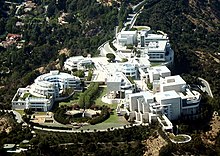J. Paul Getty Museum
 |
|
| Established | 1974 |
|---|---|
| Location | 1200 Getty Center Drive, Los Angeles, California; and 17985 Pacific Coast Highway, Pacific Palisades, Los Angeles, California |
| Coordinates | 34°04′39″N 118°28′30″W / 34.07750°N 118.47500°WCoordinates: 34°04′39″N 118°28′30″W / 34.07750°N 118.47500°W |
| Type | Art museum |
| Visitors | 1.7 million (2013) Ranking 27th globally (2013) |
| Director | Timothy Potts |
| Website | http://www.getty.edu/art |
The J. Paul Getty Museum, commonly referred to as the Getty, is an art museum in California housed on two campuses: the Getty Center and Getty Villa.
The Getty Center is in the Brentwood neighborhood of Los Angeles and is the primary location of the museum. The collection features Western art from the Middle Ages to the present. Its estimated 1.3 million visitors annually make it one of the most visited museums in the United States. The museum's second location, the Getty Villa, is in the Pacific Palisades neighborhood (though self-claims in the city of Malibu) and displays art from ancient Greece, Rome, and Etruria.
In 1974, J. Paul Getty opened a museum in a re-creation of the Villa of the Papyri at Herculaneum on his property in Pacific Palisades, California. In 1982, the museum became the richest in the world when it inherited US$1.2 billion. In 1983, after an economic downturn in what was then West Germany, the Getty Museum acquired 144 illuminated medieval manuscripts from the financially struggling Ludwig Collection in Aachen; John Russell, writing in The New York Times, said of the collection, "One of the finest holdings of its kind ever assembled, it is quite certainly the most important that was in private hands." In 1997, the museum moved to its current location in the Brentwood neighborhood of Los Angeles; the Pacific Palisades museum, renamed the "Getty Villa", was renovated and reopened in 2006.
...
Wikipedia
